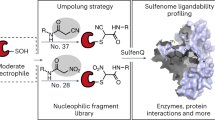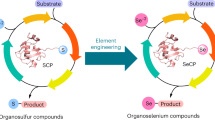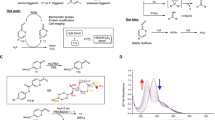Abstract
The presence of sulfur in cofactors has been appreciated for over a century, but the trafficking and delivery of sulfur to cofactors and nucleosides is still not fully understood. In the last decade, great strides have been made toward understanding those processes and the enzymes that conduct them, including cysteine desulfurases and rhodanese homology domain proteins. The persulfide group (R–S–SH) predominantly serves as the sulfur donor, and sulfur incorporation pathways share enzymes to a remarkable degree. Mechanisms for the use of persulfide groups are illustrated with the relatively simple case of 4-thiourdine generation, and further possibilities are illuminated by the 2-thiouridine and cofactor biosynthetic systems. The rationale and ramifications of sharing enzymes between sulfur incorporation pathways are discussed, including implications for interpreting genetic or genomic data that indicate a role for a sulfur transfer protein in a particular biological process.
This is a preview of subscription content, access via your institution
Access options
Subscribe to this journal
Receive 12 print issues and online access
$259.00 per year
only $21.58 per issue
Buy this article
- Purchase on Springer Link
- Instant access to full article PDF
Prices may be subject to local taxes which are calculated during checkout


Similar content being viewed by others
References
Fontecave, M., Atta, M. & Mulliez, E. S-Adenosylmethionine: nothing goes to waste. Trends Biochem. Sci. 29, 243–249 (2004).
Kluger, R. Thiamin diphosphate: a mechanistic update on enzymatic and nonenzymic catalysis of decarboxylation. Chem. Rev. 87, 863–876 (1987).
Hille, R., Retey, J., Bartlewski-Hof, U., Reichenbecher, W. & Schink, B. Mechanistic aspects of molybdenum-containing enzymes. FEMS Microbiol. Rev. 22, 489–501 (1998).
Knowles, J.R. The mechanism of biotin-dependent enzymes. Annu. Rev. Biochem. 58, 195–221 (1989).
Grant, A.S. Computational evidence for sulfur participation in the first half-reaction of biotin-catalyzed carboxylations. J. Mol. Struct. Theochem. 422, 79–87 (1998).
Attwood, P.V. & Wallace, J.C. Chemical and catalytic mechanisms of carboxyl transfer reactions in biotin-dependent enzymes. Acc. Chem. Res. 35, 113–120 (2002).
Grosjean, H. & Benne, R. Modification and Editing of RNA (American Society for Microbiology, Washington, D.C., 1998).
Sekowska, A., Kung, H.F. & Danchin, A. Sulfur metabolism in Escherichia coli and related bacteria: facts and fiction. J. Mol. Microbiol. Biotechnol. 2, 145–177 (2000).
Hwang, C.C., Woehl, E.U., Minter, D.E., Dunn, M.F. & Cook, P.F. Kinetic isotope effects as a probe of the β-elimination reaction catalyzed by O-acetylserine sulfhydrylase. Biochemistry 35, 6358–6365 (1996).
Tai, C.H., Nalabolu, S.R., Jacobson, T.M., Minter, D.E. & Cook, P.F. Kinetic mechanisms of the A and B isozymes of O-acetylserine sulfhydrylase from Salmonella typhimurium LT-2 using the natural and alternative reactants. Biochemistry 32, 6433–6442 (1993).
Toohey, J.I. Sulfane sulfur in biological systems: a possible regulatory role. Biochem. J. 264, 625–632 (1989).
Mihara, H. & Esaki, N. Bacterial cysteine desulfurases: their function and mechanisms. Appl. Microbiol. Biotechnol. 60, 12–23 (2002).
Zheng, L., White, R.H., Cash, V.L. & Dean, D.R. Mechanism for the desulfurization of L-cysteine catalyzed by the nifS gene product. Biochemistry 33, 4714–4720 (1994).
Flint, D.H. Escherichia coli contains a protein that is homologous in function and N-terminal sequence to the protein encoded by the nifS gene of Azotobacter vinelandii and that can participate in the synthesis of the Fe-S cluster of dihydroxy-acid dehydratase. J. Biol. Chem. 271, 16068–16074 (1996).
Mihara, H., Kurihara, T., Yoshimura, T., Soda, K. & Esaki, N. Cysteine sulfinate desulfinase, a NIFS-like protein of Escherichia coli with selenocysteine lyase and cysteine desulfurase activities: gene cloning, purification, and characterization of a novel pyridoxal enzyme. J. Biol. Chem. 272, 22417–22424 (1997).
Mihara, H. et al. A nifS-like gene, csdB, encodes an Escherichia coli counterpart of mammalian selenocysteine lyase: gene cloning, purification, characterization and preliminary X-ray crystallographic studies. J. Biol. Chem. 274, 14768–14772 (1999).
Patzer, S.I. & Hantke, K. SufS is a NifS-like protein, and SufD is necessary for stability of the [2Fe-2S] FhuF protein in Escherichia coli. J. Bacteriol. 181, 3307–3309 (1999).
Lauhon, C.T. & Kambampati, R. The iscS gene in Escherichia coli is required for the biosynthesis of 4-thiouridine, thiamin, and NAD+. J. Biol. Chem. 275, 20096–20103 (2000).
Mihara, H. et al. The iscS gene is essential for the biosynthesis of 2-selenouridine in tRNA and the selenocysteine-containing formate dehydrogenase H. Proc. Natl. Acad. Sci. USA 99, 6679–6683 (2002).
Loiseau, L. et al. Analysis of the heteromeric CsdA-CsdE cysteine desulfurase, assisting Fe-S cluster biogenesis in Escherichia coli. J. Biol. Chem. 280, 26760–26769 (2005).
Leimkuhler, S. & Rajagopalan, K.V. A sulfurtransferase is required in the transfer of cysteine sulfur in the in vitro synthesis of molybdopterin from precursor Z in Escherichia coli. J. Biol. Chem. 276, 22024–22031 (2001).
Outten, F.W., Wood, M.J., Munoz, F.M. & Storz, G. The SufE protein and the SufBCD complex enhance SufS cysteine desulfurase activity as part of a sulfur transfer pathway for Fe-S cluster assembly in Escherichia coli. J. Biol. Chem. 278, 45713–45719 (2003).
Mihara, H., Kurihara, T., Yoshimura, T. & Esaki, N. Kinetic and mutational studies of three NifS homologs from Escherichia coli: mechanistic difference between L-cysteine desulfurase and L-selenocysteine lyase reaction. J. Biochem. 127, 559–567 (2000).
Westley, J. Rhodanese. Adv. Enzymol. 39, 327–368 (1973).
Knowles, C.J. Microorganisms and cyanide. Bacteriol. Rev. 40, 652–680 (1976).
Nandi, D.L., Horowitz, P.M. & Westley, J. Rhodanese as a thioredoxin oxidase. Int. J. Biochem. Cell Biol. 32, 465–473 (2000).
Bordo, D. & Bork, P. The rhodanese/Cdc25 phosphatase superfamily: sequence-structure-function relations. EMBO Rep. 3, 741–746 (2002).
Palenchar, P.M., Buck, C.J., Cheng, H., Larson, T.J. & Mueller, E.G. Evidence that ThiI, an enzyme shared between thiamin and 4-thiouridine biosynthesis, may be a sulfurtransferase that proceeds through a persulfide intermediate. J. Biol. Chem. 275, 8283–8286 (2000).
Matthies, A., Rajagopalan, K.V., Mendel, R.R. & Leimkuhler, S. Evidence for the physiological role of a rhodanese-like protein for the biosynthesis of the molybdenum cofactor in humans. Proc. Natl. Acad. Sci. USA 101, 5946–5951 (2004).
Matthies, A., Nimtz, M. & Leimkuhler, S. Molybdenum cofactor biosynthesis in humans: identification of a persulfide group in the rhodanese-like domain of MOCS3 by mass spectrometry. Biochemistry 44, 7912–7920 (2005).
Wolfe, M.D. et al. Functional diversity of the rhodanese homology domain: the Escherichia coli ybbB gene encodes a selenophosphate-dependent tRNA 2-selenouridine synthase. J. Biol. Chem. 279, 1801–1809 (2004).
Favre, A., Yaniv, M. & Michelson, A.M. The photochemistry of 4-thiouridine in Escherichia coli transfer RNAIVal. Bioch. Biophys. Res. Commun. 37, 266–271 (1969).
Favre, A., Michelson, A.M. & Yaniv, M. Photochemistry of 4-thiouridine in Escherichia coli transfer RNA1Val. J. Mol. Biol. 58, 367–379 (1971).
Carre, D.S., Thomas, G. & Favre, A. Conformation and functioning of transfer RNAs: crosslinked transfer RNAs as substrate for transfer RNA nucleotidyl-transferase and aminoacyl synthetases. Biochimie 56, 1089–1101 (1974).
Ryals, J., Hsu, R.-Y., Lipsett, M.N. & Bremer, H. Isolation of single-site Escherichia coli mutants deficient in thiamine and 4-thiouridine syntheses: identification of a nuvC mutant. J. Bacteriol. 151, 899–904 (1982).
Peterkofsky, A. & Lipsett, M.N. The origin of the sulfur in s-RNA. Bioch. Biophys. Res. Commun. 20, 780–786 (1965).
Lipsett, M.N., Norton, J.S. & Peterkofsky, A. A requirement for β-mercaptopyruvate in the in vitro thiolation of transfer ribonucleic acid. Biochemistry 6, 855–860 (1967).
Lipsett, M.N. & Peterkofsky, A. Enzymatic thiolation of E. coli sRNA. Proc. Natl. Acad. Sci. USA 55, 1169–1174 (1966).
Lipsett, M.N. Biosynthesis of 4-thiuridylate: participation of a sulfurtransferase containing pyridoxal 5′-phosphate. J. Biol. Chem. 247, 1458–1461 (1972).
Abrell, J.W., Kaufman, D.E. & Lipsett, M.N. The biosynthesis of 4-thiouridylate: separation and purification of two enzymes in the transfer ribonucleic acid-sulfurtransferase system. J. Biol. Chem. 246, 294–301 (1971).
Mueller, E.G., Buck, C.J., Palenchar, P.M., Barnhart, L.E. & Paulson, J.L. Identification of a gene involved in the generation of 4-thiouridine in tRNA. Nucleic Acids Res. 26, 2606–2610 (1998).
Kambampati, R. & Lauhon, C.T. IscS is a sulfurtransferase for the in vitro biosynthesis of 4-thiouridine in Escherichia coli tRNA. Biochemistry 38, 16561–16568 (1999).
Kambampati, R. & Lauhon, C.T. Evidence for the transfer of sulfane sulfur from IscS to ThiI during the in vitro biosynthesis of 4-thiouridine in Escherichia coli tRNA. J. Biol. Chem. 275, 10727–10730 (2000).
Mueller, E.G., Palenchar, P.M. & Buck, C.J. The role of the cysteine residues of ThiI in the generation of 4-thiouridine in tRNA. J. Biol. Chem. 276, 33588–33595 (2001).
Wright, C.M., Palenchar, P.M. & Mueller, E.G. A paradigm for biological sulfur transfers via persulfide groups: a persulfide-disulfide-thiol cycle in 4-thiouridine biosynthesis. Chem. Commun. 22, 2708–2709 (2002).
Lauhon, C.T., Erwin, W.M. & Ton, G.N. Substrate specificity for 4-thiouridine modification in Escherichia coli. J. Biol. Chem. 279, 23022–23029 (2004).
Schendel, F.J., Mueller, E., Stubbe, J., Shiau, A. & Smith, J.M. Formylglycinamide ribonucleotide synthetase from Escherichia coli: cloning, sequencing, overproduction, isolation, and characterization. Biochemistry 28, 2459–2471 (1989).
Badet-Denisot, M.A., Rene, L. & Badet, B. Mechanistic investigations on glucosamine-6-phosphate synthase. Bull. Soc. Chim. Fr. 130, 249–255 (1993).
Igeno, M.I., Caballero, F.J. & Castillo, F. Molecular and kinetic characterization of glutamate synthase from the phototrophic bacterium Rhodobacter capsulatus E1f1. J. Gen. Microbiol. 139, 2921–2929 (1993).
Thoden, J.B., Holden, H.M., Wesenberg, G., Raushel, F.M. & Rayment, I. Structure of carbamoyl phosphate synthetase: a journey of 96 Å from substrate to product. Biochemistry 36, 6305–6316 (1997).
Raushel, F.M., Thoden, J.B. & Holden, H.M. Enzymes with molecular tunnels. Acc. Chem. Res. 36, 539–548 (2003).
Waterman, D.G., Ortiz-Lombardia, M., Fogg, M.J., Koonin, E.V. & Antson, A.A. Crystal structure of Bacillus anthracis ThiI, a tRNA-modifying enzyme containing the predicted RNA-binding THUMP domain. J. Mol. Biol. 356, 97–110 (2006).
Kambampati, R. & Lauhon, C.T. MnmA and IscS are required for in vitro 2-thiouridine biosynthesis in Escherichia coli. Biochemistry 42, 1109–1117 (2003).
Ikeuchi, Y., Shigi, N., Kato, J.-i., Nishimura, A. & Suzuki, T. Mechanistic insights into sulfur relay by multiple sulfur mediators involved in thiouridine biosynthesis at tRNA wobble positions. Mol. Cell 21, 97–108 (2006).
Lauhon, C.T., Skovran, E., Urbina, H.D., Downs, D.M. & Vickery, L.E. Substitutions in an active site loop of Escherichia coli IscS result in specific defects in Fe-S cluster and thionucleoside biosynthesis in vivo. J. Biol. Chem. 279, 19551–19558 (2004).
Nilsson, K., Lundgren, H.K., Hagervall, T.G. & Bjork, G.R. The cysteine desulfurase IscS is required for synthesis of all five thiolated nucleosides present in tRNA from Salmonella enterica serovar Typhimurium. J. Bacteriol. 184, 6830–6835 (2002).
Leipuviene, R., Qian, Q. & Bjork, G.R. Formation of thiolated nucleosides present in tRNA from Salmonella enterica serovar Typhimurium occurs in two principally distinct pathways. J. Bacteriol. 186, 758–766 (2004).
Lundgren, H.K. & Bjork, G.R. Structural alterations of the cysteine desulfurase IscS of Salmonella enterica serovar Typhimurium reveals substrate specificity by IscS in tRNA thiolation. J. Bacteriol. (in the press).
Cupp-Vickery, J.R., Urbina, H. & Vickery, L.E. Crystal structure of IscS, a cysteine desulfurase from Escherichia coli. J. Mol. Biol. 330, 1049–1059 (2003).
Leimkuhler, S., Wuebbens, M.M. & Rajagopalan, K.V. Characterization of Escherichia coli MoeB and its involvement in the activation of molybdopterin synthase for the biosynthesis of the molybdenum cofactor. J. Biol. Chem. 276, 34695–34701 (2001).
Lake, M.W., Wuebbens, M.M., Rajagopalan, K.V. & Schindelin, H. Mechanism of ubiquitin activation revealed by the structure of a bacterial MoeB-MoaD complex. Nature 414, 325–329 (2001).
Taylor, S.V. et al. Thiamin biosynthesis in Escherichia coli: identification of ThiS thiocarboxylate as the immediate sulfur donor in the thiazole formation. J. Biol. Chem. 273, 16555–16560 (1998).
Xi, J., Ge, Y., Kinsland, C., McLafferty, F.W. & Begley, T.P. Biosynthesis of the thiazole moiety of thiamin in Escherichia coli: identification of an acyldisulfide-linked protein–protein conjugate that is functionally analogous to the ubiquitin/E1 complex. Proc. Natl. Acad. Sci. USA 98, 8513–8518 (2001).
Lehmann, C., Begley, T.P. & Ealick, S.E. Structure of the Escherichia coli ThiS-ThiF complex, a key component of the sulfur transfer system in thiamin biosynthesis. Biochemistry 45, 11–19 (2006).
Johnson, D.C., Dean, D.R., Smith, A.D. & Johnson, M.K. Structure, function, and formation of biological iron-sulfur clusters. Annu. Rev. Biochem. 74, 247–281 (2005).
Sofia, H.J., Chen, G., Hetzler, B.G., Reyes-Spindola, J.F. & Miller, N.E. Radical SAM, a novel protein superfamily linking unresolved steps in familiar biosynthetic pathways with radical mechanisms: functional characterization using new analysis and information visualization methods. Nucleic Acids Res. 29, 1097–1106 (2001).
Cheek, J. & Broderick, J.B. Adenosylmethionine-dependent iron-sulfur enzymes: versatile clusters in a radical new role. J. Biol. Inorg. Chem. 6, 209–226 (2001).
Frey, P.A. Radical mechanisms of enzymatic catalysis. Annu. Rev. Biochem. 70, 121–148 (2001).
Bui, B.T.S. et al. Biotin synthase mechanism: on the origin of sulphur. FEBS Lett. 440, 226–230 (1998).
Ollagnier-de Choudens, S. & Fontecave, M. The lipoate synthase from Escherichia coli is an iron-sulfur protein. FEBS Lett. 453, 25–28 (1999).
Miller, J.R. et al. Escherichia coli LipA is a lipoyl synthase: in vitro biosynthesis of lipoylated pyruvate dehydrogenase complex from octanoyl-acyl carrier protein. Biochemistry 39, 15166–15178 (2000).
Pierrel, F., Douki, T., Fontecave, M. & Atta, M. MiaB protein is a bifunctional radical-S-adenosylmethionine enzyme involved in thiolation and methylation of tRNA. J. Biol. Chem. 279, 47555–47563 (2004).
Pierrel, F., Bjork, G.R., Fontecave, M. & Atta, M. Enzymatic modification of tRNAs: MiaB is an iron-sulfur protein. J. Biol. Chem. 277, 13367–13370 (2002).
Gibson, K.J., Pelletier, D.A. & Turner, I.M. Transfer of sulfur to biotin from biotin synthase (BioB protein). Bioch. Biophys. Res. Commun. 254, 632–635 (1999).
Cicchillo, R.M. & Booker, S.J. Mechanistic investigations of lipoic acid biosynthesis in Escherichia coli: both sulfur atoms in lipoic acid are contributed by the same lipoyl synthase polypeptide. J. Am. Chem. Soc. 127, 2860–2861 (2005).
Ugulava, N.B., Sacanell, C.J. & Jarrett, J.T. Spectroscopic changes during a single turnover of biotin synthase: destruction of a 2Fe-2S cluster accompanies sulfur insertion. Biochemistry 40, 8352–8358 (2001).
Sauerwald, A. et al. RNA-dependent cysteine biosynthesis in archaea. Science 307, 1969–1972 (2005).
O'Donoghue, P., Sethi, A., Woese, C.R. & Luthey-Schulten, Z.A. The evolutionary history of Cys-tRNA(Cys) formation. Proc. Natl. Acad. Sci. USA 102, 19003–19008 (2005).
Burns, K.E. et al. Reconstitution of a new cysteine biosynthetic pathway in Mycobacterium tuberculosis. J. Am. Chem. Soc. 127, 11602–11603 (2005).
Stadtman, T.C. Selenium biochemistry. Annu. Rev. Biochem. 59, 111–127 (1990).
Veres, Z., Kim, L., Scholz, T.D. & Stadtman, T.C. Selenophosphate synthetase: enzyme properties and catalytic reaction. J. Biol. Chem. 269, 10597–10603 (1994).
Lacourciere, G.M. & Stadtman, T.C. The NifS protein can function as a selenide delivery protein in the biosynthesis of selenophosphate. J. Biol. Chem. 273, 30921–30926 (1998).
Lacourciere, G.M. Selenium is mobilized in vivo from free selenocysteine and is incorporated specifically into formate dehydrogenase H and tRNA nucleosides. J. Bacteriol. 184, 1940–1946 (2002).
Webb, E., Claas, K. & Downs, D.M. Characterization of thiI, a new gene involved in thiazole biosynthesis in Salmonella typhimurium. J. Bacteriol. 179, 4399–4402 (1997).
Mueller, E.G. & Palenchar, P.M. Using genomic information to investigate the function of ThiI, an enzyme shared between thiamin and 4-thiouridine biosynthesis. Protein Sci. 8, 2424–2427 (1999).
Park, J.H. et al. Biosynthesis of the thiazole moiety of thiamin pyrophosphate (vitamin B1). Biochemistry 42, 12430–12438 (2003).
Leonardi, R. & Roach, P.L. Thiamine biosynthesis in Escherichia coli: in vitro reconstitution of the thiazole synthase activity. J. Biol. Chem. 279, 17054–17062 (2004).
Acknowledgements
E.G.M. acknowledges the US National Institutes of Health for the financial support of his research provided by grant GM59636 and G.R. Björk for providing a preprint of a manuscript in press.
Author information
Authors and Affiliations
Corresponding author
Ethics declarations
Competing interests
The author declares no competing financial interests.
Rights and permissions
About this article
Cite this article
Mueller, E. Trafficking in persulfides: delivering sulfur in biosynthetic pathways. Nat Chem Biol 2, 185–194 (2006). https://doi.org/10.1038/nchembio779
Published:
Issue Date:
DOI: https://doi.org/10.1038/nchembio779
This article is cited by
-
Sulfur sequestration promotes multicellularity during nutrient limitation
Nature (2021)
-
Functional elucidation of TfuA in peptide backbone thioamidation
Nature Chemical Biology (2021)
-
Understanding the mechanism of H2S oxidation by flavin-dependent sulfide oxidases: a DFT/IEF-PCM study
Journal of Molecular Modeling (2019)
-
Biosynthesis of thiocarboxylic acid-containing natural products
Nature Communications (2018)
-
Analysis of Streptomyces coelicolor M145 genes SCO4164 and SCO5854 encoding putative rhodaneses
Folia Microbiologica (2018)



